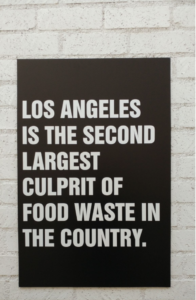
We throw away enough perfectly edible food to feed more than every hungry person in America. Approximately $218 billion is spent on growing, processing, and then throwing away 63 million tons of food every year. Ask anyone who lived through the Great Depression; food waste is a sin. Less than a century ago eating potato peels and cooking bones into broth was as commonplace as millennials ‘gramming their bottomless-mimosa Sunday brunch.
What holds us back from returning to our efficient habits with food? Amongst other complicated systematic societal flaws, the largest culprit is convenience. America wastes around 40% of the food that it produces; starting with culling ugly produce at the farm, down to spoiled perishables lost in transportation, then grocery stores overstocking shelves with products stamped with confusing “best by” labels, and restaurants piling single plates with enough to feed an entire soccer team, but most importantly: consumers are buying more than they will ever find the time to cook. We want pretty food from far away places on full plates, and we only want to eat half of it before we remember to save room for dessert.
 Nearly 80% of all food waste comes from consumers and consumer-facing businesses. Most food waste on farms is composted or tilled back into the soil, however, an estimated 63 million tons of food from restaurants, manufacturers, grocery stores, hotels, and homes are sent to the landfill every year, decomposing into the toxic greenhouse gas: methane. In case you didn’t know, methane is the stuff that makes cow farts smelly.
Nearly 80% of all food waste comes from consumers and consumer-facing businesses. Most food waste on farms is composted or tilled back into the soil, however, an estimated 63 million tons of food from restaurants, manufacturers, grocery stores, hotels, and homes are sent to the landfill every year, decomposing into the toxic greenhouse gas: methane. In case you didn’t know, methane is the stuff that makes cow farts smelly.
Despite the alarming amount of money that is spent in destroying edible food, we continue to spend even more on emergency relief food for those who can’t afford it. Approximately 12% of the US population is “food insecure” and struggles for at least part of the month to put food on the table. In Los Angeles alone, one in every seven people and one in four children don’t always know when their next meal is coming. Folks often rely on government assistance programs, food banks, or local charities to find nutrition in situations like when the paycheck must be spent on rent and not on food.
 But many businesses are still afraid to donate food because of a common misunderstanding about liability. That’s why government policy is fighting to protect us. In 1996, the Good Samaritan Food Act was passed to protect businesses from any liability when they donate edible food in good faith that it’s safe for consumption to nonprofits that feed the hungry. In California, the policy was expanded to provide protection to individual donors and direct business-to-person donations. That’s right! The old wives’ tale about people getting sued for donating food is completely false. And better yet, food donations are tax-deductible. Gotta love it when going green saves green.
But many businesses are still afraid to donate food because of a common misunderstanding about liability. That’s why government policy is fighting to protect us. In 1996, the Good Samaritan Food Act was passed to protect businesses from any liability when they donate edible food in good faith that it’s safe for consumption to nonprofits that feed the hungry. In California, the policy was expanded to provide protection to individual donors and direct business-to-person donations. That’s right! The old wives’ tale about people getting sued for donating food is completely false. And better yet, food donations are tax-deductible. Gotta love it when going green saves green.
Even with a government-backed effort to increase food donation, finding a local charity to donate to can be daunting. Fortunately, a Los Angeles company created a technology platform called Careit to handle all of those logistics. Careit connects businesses and individuals with surplus, edible food or goods with the right nonprofit to rescue it. It can also track donations to make reporting on corporate social responsibility a sinch and bring money back from Uncle Sam. Careit’s donation dashboard also manages reporting for state policy like SB 1383, so municipalities can use it as well. Visit careit.com for more information, and to see when the platform will be available to use in your community.










